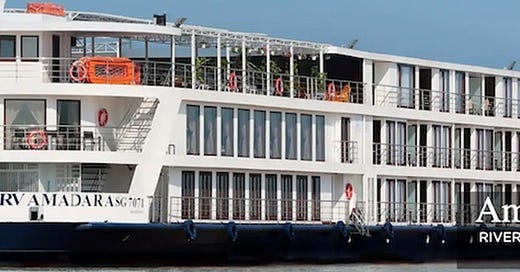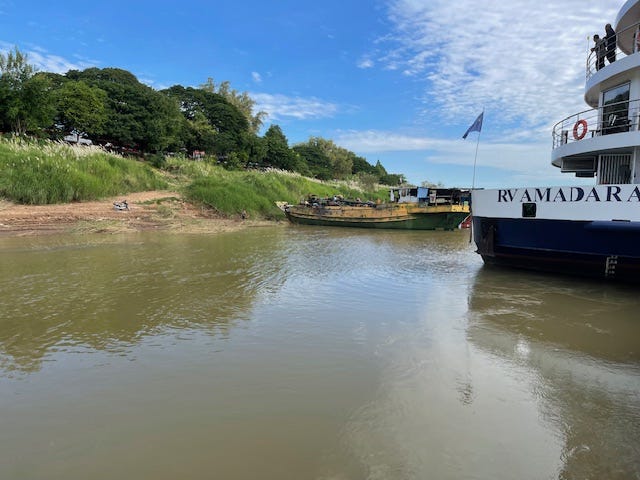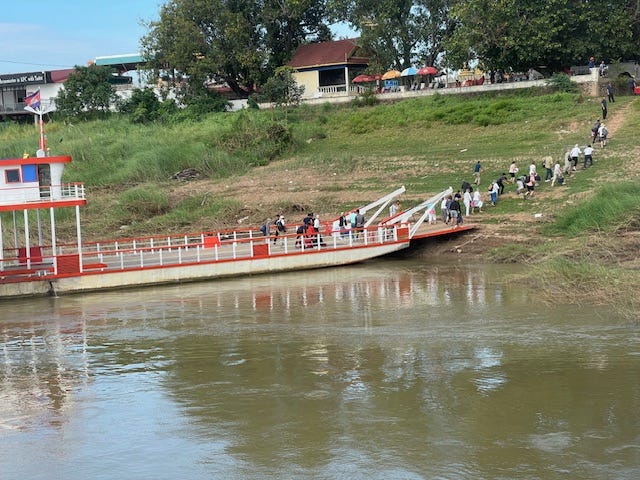Energy Musings - December 19, 2023
The following two blogs were posted on Workboat.com during our recent trip to Viet Nam and Cambodia. Our river cruise ship got stuck for several days on a sand bar. We have added pictures below.
A Truly Amazing Experience In Cambodia
December 4, 2023
Our river cruise ship AmaDara was our home for eight days and seven nights traveling up the Mekong River from south of Ho Chi Minh City in Viet Nam to Khampong Cham in Cambodia.
AmaWaterways photo
Always have a Plan B and more
We were on an eight-day, seven-night cruise on the Mekong River in Vietnam and Cambodia recently when, approaching our final stop, Kampong Cham in Cambodia, when the trip went sideways. The schedule called for a late afternoon visit to a neighboring temple before dinner and spending the night. We were to disembark the following morning to drive to Siem Reap.
My wife and I were in our cabin relaxing before the afternoon tour when we sensed that our cruise ship, the AmaDara, had hit bottom. But the ship continued to maneuver toward shore where we were scheduled to exit. We noticed that in our port-side cabin we had to walk uphill to our door. Our bathroom door was largely closed because of the ship’s listing.
It wasn’t until we went to our meeting place for the pre-tour briefing that we discovered that we were not at a docking station. We were told that there were two other river cruise ships occupying the docks, so we had to go to the alternative docking station.
The vessel was perpendicular to the shore but quite a distance away. We watched the crew talking and then our tour guides. We were stuck. Nobody seemed sure what to do next.
By stuck, I mean stuck. When we went to the bow, we could see that we were stuck in the mud of the shoreline. There were mud flats to our port side and shallow water to our starboard side. The captain was trying to back the ship off the mud flats but to no avail. When we walked by the wheelhouse, there were no smiling faces.
A small wooden boat that assists ships in docking was off our bow. The problem was that there was a very strong wind blowing on the starboard side. If you are familiar with river cruise ships, they are narrow and tall. That meant the stiff wind was probably pushing us farther into the mud flats. The little wooden boat took a line from the ship and tried to pull us off from the starboard side, but he was working against the wind pushing us into the mud flats. That effort didn’t go very far.
Plan A didn’t work. Time for Plan B. One of the cruise ships docked ahead came down. The little wooden boat took a line from our port stern to the Mekong Jewel. After fastening the line – a distance of roughly 200’ – she tried pulling upriver as our ship put its engine in reverse.
We were standing on the stern watching the effort. As the Mekong Jewel pulled, the line popped loose. So much for Plan B. On to Plan C. The Mekong Jewel repositioned itself and the wooden boat brought the line back. This time, the line was secured to our starboard stern cleat. After pulling and pulling, and the AmaDara revving up its engines, there was still no movement. The Mekong Jewel disconnected and left.
We are waiting to hear the details about Plan D. Not surprisingly, the captain was not present at the captain’s farewell cocktail party. We suspect this will be a huge black mark on his performance evaluation. The message we got was: “We are working on options and will keep you informed.”
December 11, 2023
Always have a Plan B and more — Part II
The first plan to get the AmaDara off the sandbar proved fruitless when the tow line snapped.
G. Allen Brooks photo
In last week’s blog, I wrote about my Vietnam and Cambodia river cruise vessel, the AmaDara, which grounded in a sandbank at our final stopping point and the efforts to get it unstuck. Now I can tell you about additional efforts that cruise vessel personnel used to try and get us off the sand bank.
We went to bed with no knowledge of what Plan D would be for getting our river cruise vessel AmaDara unstuck. Ship and cruise officials assured us they were working on multiple options. Since they didn’t know that night which one the company would try, they told us we would find out in the morning.
At 2 a.m., we awoke to the roar of diesel engines. Thinking it was our ship trying to back out from the sandbar, we got up to look. We were greeted with spotlights and two river mining ships trying to pump sand and water away from our ship’s hull. These miners were lined up directly with our cabin. For nearly two-and-a-half hours we were serenaded by the sound of diesel engines pumping away. Goodbye to any thoughts of sleep.
When the noise stopped, we concluded Plan D must have worked and our ship had been freed. At daybreak, we discovered that no, we were still stuck. So, what was the next plan?
Going on deck brought the revelation that a ferry boat was present. Of course, load us onto the ferry and deliver us to the real docking station. As the 100-plus pieces of luggage were loaded onto the ferry, the question was if the luggage was heading to the dock or just to the riverbank. The answer was the riverbank. The ship’s crew carried all the luggage up the steep 75-foot embankment. Oh boy, we were going to have to make that same climb to reach our buses.
The climb proved less challenging with the aid of crewmembers who helped passengers who were less mobile. Once loaded on to the buses, we were off to Siem Reap, a five-hour trip. We were told that the river miners not only pumped away water and sand but had also emptied the ship’s hull of any accumulated water and sand, helping to lighten the ship. We were also told that a tug was being summoned to help.
The next morning, we were told the ship had been freed the previous evening. We also learned that the two river mining boats began pumping sand away and five tugs arrived to pull the AmaDara from its parked position.
I didn’t see any tugs on the river journey since Phnom Penh, so I guessed that the tugs needed to make the long journey from Phnom Penh and Kampong Chem which is about 125 kilometers (78 miles). Since no vessels that I saw were going very fast on the Mekong River, partly because of the current, I estimated that the tug might travel at a top speed of 10 miles per hour for a roughly eight-hour journey. Not one but five tugs were needed to free our ship. It’s better to have too much rather than too little pulling power.
Dollar signs spin in my head when I think about what the cost was to free the AmaDara. Essentially, a full day’s time and the cost of the fuel up and back to Phnom Penh for the five tugs would make up much of the bill. Then there was the charter expense for the two river mining vessels. This cruise trip may have cost the cruise operator, AmaWaterways, a lot of money.
It will be interesting to see if we hear anything from the company, or whether the mishap disappears into a memory black hole. I must believe that the first mate, who was at the wheel when the AmaDara went aground, lost his job. Did this incident end his career?
Addendum:
At the end of the cruise, the cruise manager was asking participants about their thoughts on the trip. When he asked for people’s high points, one wise guy said, “Getting stuck on the sand bar.” The cruise manager laughed (as did everyone else) and moved on.
We have heard nothing from AmaWaterways about the incident. That said, this was our second river cruise with AmaWaterways and they do a wonderful job. We would certainly travel with them again.
Other pictures we took:








